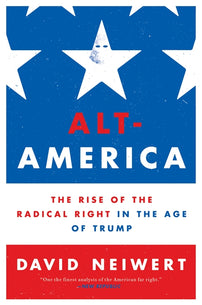Five Book Plan: The Radical Right in America
David Neiwert, author of Alt-America, picks his essential reads on the American far right.

David Neiwert is a journalist and author and an acknowledged expert in American right-wing extremism. He is the Pacific Northwest correspondent for the Southern Poverty Law Center. He has appeared on Anderson Cooper 360, CNN Newsroom, and The Rachel Maddow Show and was the Managing Editor of the popular political blog Crooks and Liars. His work has also appeared in the American Prospect, the Washington Post, MSNBC.com, Salon.com, and other publications.
His new book, Alt-America: The Rise of the Radical Right in the Age of Trump, is out now and 40% off until Tuesday, October 24 at 11:59PM PST.
1. James Ridgeway, Blood In the Face: The Ku Klux Klan, Aryan Nations, Nazi Skinheads, and the Rise of a New White Culture (New York: Thunder’s Mouth Press, 1995)
This book is probably the most accessible overview of the history of the radical right in America, though it is limited in that it only tells the story up through the 1990s. But it is lively, accurate, and appropriately disturbing.
2. Daniel Levitas, The Terrorist Next Door: The Militia Movement and the Radical Right (New York: Thomas Dunne Books, 2002)
No one understands the deep history of the extremist right better than Levitas, and this magisterial work makes for daunting but ultimately rewarding reading. Levitas traces in great and illuminating detail the history of the far-right Posse Comitatus movement of the ‘70s and ‘80s, and how it then gave birth to the militia/Patriot movement.
3. Chip Berlet and Matthew Lyons, Right Wing Populism: Too Close For Comfort (New York: The Guilford Press, 2000)
Berlet and Lyons offer a helpful theoretical framework for understanding the extreme right in America, placing it in the context of the long and deep traditions of right-wing populism that trace back to the nation’s origins. It is also a chilling framework, since fascism also traces its origins to right-wing populism.
4. Leonard Zeskind, Blood and Politics: The History of the White Nationalist Movement from the Margins to the Mainstream (New York: Farrar Straus Giroux, 2009)
No one has tracked and reported on the radical right in the U.S. longer than Zeskind, and few have been as sharply insightful about the dynamics that empower them. This book is long, dense, and exhaustive, and it contains a wealth of chilling factual detail about white nationalism: how they think, how they organize, and how they scheme to seize power.
5. Robert O. Paxton, The Anatomy of Fascism (New York: Vintage, 2005)
The most fascinating aspect of Paxton’s authoritative historical analysis of fascism is how, even though it is focused on the historical antecedents in Germany and Italy, it accurately describes the dynamics of such American proto-fascist elements as the neo-Nazi movement and the Ku Klux Klan. Paxton’s explanation of how fascism operates, how it grows, how it takes root, and how it seizes power, make this text essential reading for our time.
[book-strip index="1" style="buy"]